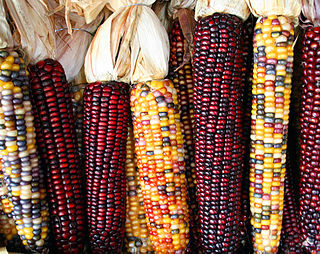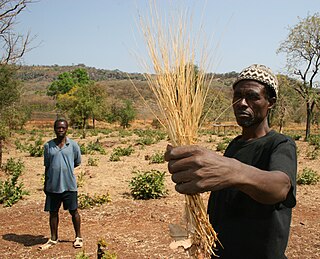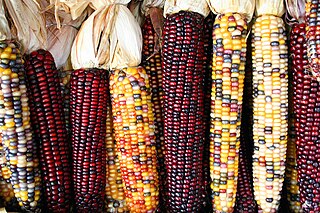
Genetically modified maize (corn) is a genetically modified crop. Specific maize strains have been genetically engineered to express agriculturally-desirable traits, including resistance to pests and to herbicides. Maize strains with both traits are now in use in multiple countries. GM maize has also caused controversy with respect to possible health effects, impact on other insects and impact on other plants via gene flow. One strain, called Starlink, was approved only for animal feed in the US but was found in food, leading to a series of recalls starting in 2000.

The oat, sometimes called the common oat, is a species of cereal grain grown for its seed, which is known by the same name. Oats appear to have been domesticated as a secondary crop, as their seeds resembled those of other cereals closely enough for them to be included by early cultivators. Oats tolerate cold winters less well than cereals such as wheat, barley, and rye, but need less summer heat and more rain, making them important in areas such as Northwest Europe that have cool wet summers. They can tolerate low-nutrient and acid soils. Oats grow thickly and vigorously, allowing them to outcompete many weeds, and compared to other cereals are relatively free from diseases.

Zea is a genus of flowering plants in the grass family. The best-known species is Z. mays, one of the most important crops for human societies throughout much of the world. The four wild species are commonly known as teosintes and are native to Mesoamerica.
Field corn, also known as cow corn, is a North American term for maize grown for livestock fodder, ethanol, cereal, and processed food products. The principal field corn varieties are dent corn, flint corn, flour corn which includes blue corn, and waxy corn.

A landrace is a domesticated, locally adapted, often traditional variety of a species of animal or plant that has developed over time, through adaptation to its natural and cultural environment of agriculture and pastoralism, and due to isolation from other populations of the species. Landraces are distinct from cultivars and from standard breeds.

Baby corn is a cereal grain taken from corn (maize) harvested early while the stalks are still small and immature. It typically is eaten whole—including the cob, which is otherwise too tough for human consumption in mature corn—in raw, pickled, and cooked forms. Baby corn is common in stir fry dishes.

Digitaria exilis, referred to as findi or fundi in areas of Africa, such as The Gambia, with English common names white fonio, fonio millet, and hungry rice or acha rice, is a grass species. It is the most important of a diverse group of wild and domesticated Digitaria species known as fonio that are harvested in the savannas of West Africa. The grains are very small. It has potential to improve nutrition, boost food security, foster rural development and support sustainable use of the land. Despite its valuable characteristics and widespread cultivation, fonio has generally received limited research and development attention, which is also why the species is sometimes referred to as an underutilized crop.

Corn stover consists of the leaves, stalks, and cobs of corn (maize) plants left in a field after harvest. Such stover makes up about half of the yield of a corn crop and is similar to straw from other cereal grasses; in Britain it is sometimes called corn straw. Corn stover is a very common agricultural product in areas of large amounts of corn production. As well as the non-grain part of harvested corn, the stover can also contain other weeds and grasses. Field corn and sweet corn, two different types of maize, have relatively similar corn stover.
Since the advent of genetic engineering in the 1970s, concerns have been raised about the dangers of the technology. Laws, regulations, and treaties were created in the years following to contain genetically modified organisms and prevent their escape. Nevertheless, there are several examples of failure to keep GM crops separate from conventional ones.
MON 863 is a genetically engineered variety of maize produced by Monsanto. It is genetically altered to express a modified version of Cry3Bb1, a delta endotoxin which originates from Bacillus thuringiensis. This protects the plant from corn rootworm. Unlike MON 810, Bt 11, and Bt 176 which each produce a modified Cry1Ab, MON 863 instead produces a modified Cry3Bb1 toxin and contains nptII, a marker gene for antibiotic resistance.
Intensive crop farming is a modern industrialized form of crop farming. Intensive crop farming's methods include innovation in agricultural machinery, farming methods, genetic engineering technology, techniques for achieving economies of scale in production, the creation of new markets for consumption, patent protection of genetic information, and global trade. These methods are widespread in developed nations.

Flint corn is a variant of maize, the same species as common corn. Because each kernel has a hard outer layer to protect the soft endosperm, it is likened to being hard as flint, hence the name. It is one of six major types of corn, the others being dent corn, pod corn, popcorn, flour corn, and sweet corn.

Maize, also known as corn in North American English, is a tall stout grass that produces cereal grain. It was domesticated by indigenous peoples in southern Mexico about 9,000 years ago from wild teosinte. Native Americans planted it alongside beans and squashes in the Three Sisters polyculture. The leafy stalk of the plant gives rise to male inflorescences or tassels which produce pollen, and female inflorescences called ears. The ears yield grain, known as kernels or seeds. In modern commercial varieties, these are usually yellow or white; other varieties can be of many colors.
The MON 810 corn is a genetically modified maize used around the world. It is a Zea mays line known as YieldGard from the company Monsanto. This plant is a genetically modified organism (GMO) designed to combat crop loss due to insects. There is an inserted gene in the DNA of MON 810 which allows the plant to make a protein that harms insects that try to eat it. The inserted gene is from the Bacillus thuringiensis which produces the Bt protein that is poisonous to insects in the order Lepidoptera, including the European corn borer.
Traditional Italian maize varieties have been, according to historical, archaeological, botany, morphological, and genetic evidence, molded since the introduction of this exotic cereal crop from the Americas in the sixteenth century.
Genetic engineering in the European Union has varying degrees of regulation.

Xenia in plants is the effect of pollen on seeds and fruit of the fertilized plant. The effect is separate from the contribution of the pollen towards the next generation.

Pod corn or wild maize is a variety of maize (corn). It is not a wild ancestor of maize but rather a mutant that forms leaves around each kernel.

The production of corn plays a major role in the economy of the United States. The US is the largest corn producer in the world, with 96,000,000 acres (39,000,000 ha) of land reserved for corn production. Corn growth is dominated by west/north central Iowa and east central Illinois. Approximately 13% of its annual yield is exported.

Stenocarpella maydis (Berk.) Sutton is a plant pathogenic fungus and causal organism of diplodia ear and stalk rot. Corn and canes are the only known hosts to date. No teleomorph of the fungus is known.













